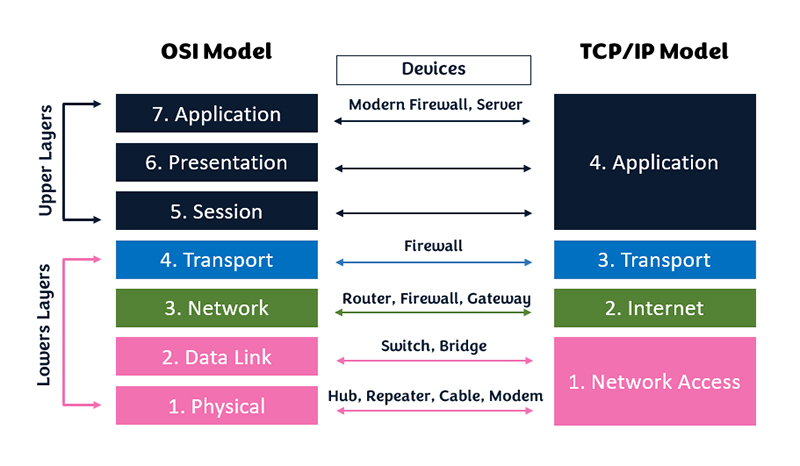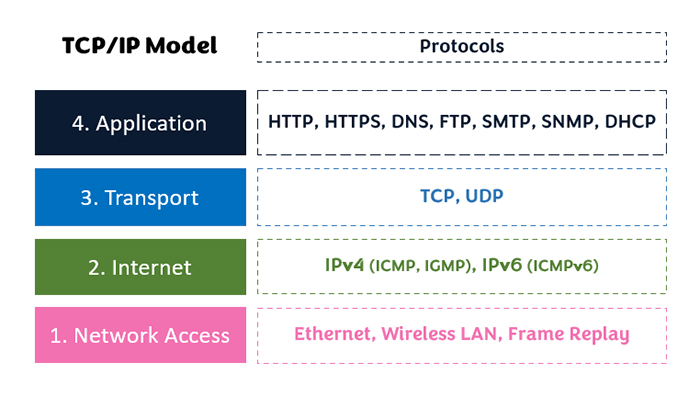The OSI (Open Systems Interconnection) model and the TCP/IP (Transmission Control Protocol/Internet Protocol) model are two conceptual frameworks that describe how the network should work.
They provide a structured approach to understanding and organizing the various aspects of network communication.
While the OSI model is a theoretical framework developed by ISO (International Organization for Standardization), the TCP/IP model is a practical implementation widely used in the Internet.

OSI Model
The OSI model is a layered approach that breaks down network communication into seven distinct layers, each with its own specific functions and responsibilities.
This model provides a standardized framework for understanding and discussing network communication concepts and protocols.
However, it is more of a theoretical model and is not directly implemented in most practical network systems.
The 7 layers of the OSI model, from bottom to top, are:
-
Physical Layer
is responsible for sending computer raw data as "bits", which is a serie of 0 and 1, from one device to another along the network.
Devices: hub, repeater, cable, and modem.
-
Data Link Layer
performs error detection and combines the data raw (bits) into frames.
This layer is responsible to transfer data as Ethernet "frames" from one device to another device based on the destination MAC address that is a hardware identifier.
Devices: switch, and bridge.
-
Network Layer
is responsible for creating routing table, and based on routing table, forwarding of the input request. This layer transmits data as "packets" that are sent based on their destination IP addresses (IPV4 or IPV6).
Devices: Router, Firewall, and Gateway.
-
Transport Layer
ensures that messages are transmitted in the order in which they are sent and there is no duplication of data. It transmits data as "segments" using TCP or UDP.
Devices: firewalls.
-
Session Layer
establishes, manages, and terminates communication sessions.
-
Presentation Layer
handles data formatting, translation, and encryption.
-
Application Layer
serves as a window for users and application processes to access network service. An application layer is not an application. It provides the network services to the end-users.
Devices: modern firewalls.
What are the upper network layers?
The upper layers refer to the Application Layer, Presentation Layer, and Session Layer in OSI Model.
These layers are responsible for providing services and interfaces to the end-user applications.
What are the lower network layers?
The lower layers refer to the Physical Layer, Data Link Layer, Network Layer, and Transport Layer in OSI Model.
They are primarily concerned with the formatting, encoding and transmission of data over the network.
They don't care that much about what the data is or what it is being used for, just about moving it around.
TCP/IP Model
The TCP/IP model is a practical implementation of network protocols widely used in the Internet.
It is based on the protocols developed by the Department of Defense (DoD) for the ARPANET, the precursor to the modern Internet.

The 4 layers of the TCP/IP model, from bottom to top, are:
-
Network Access
deals with the physical transmission and framing of data on the network medium.
Protocols: Ethernet, Wireless LAN, and Frame Replay.
-
Internet
handles logical addressing and routing of data packets across networks.
Protocols: IPv4 (ICMP, IGMP), and IPv6 (ICMPv6)
-
Transport
ensures reliable end-to-end data delivery, managing connections and providing services such as segmentation and reassembly.
Protocols: TCP, and UDP.
-
Application
Provides application-specific services and protocols directly to end-user applications.
Protocols: HTTP, HTTPS, DNS, FTP, SMTP, SNMP, and DHCP.



